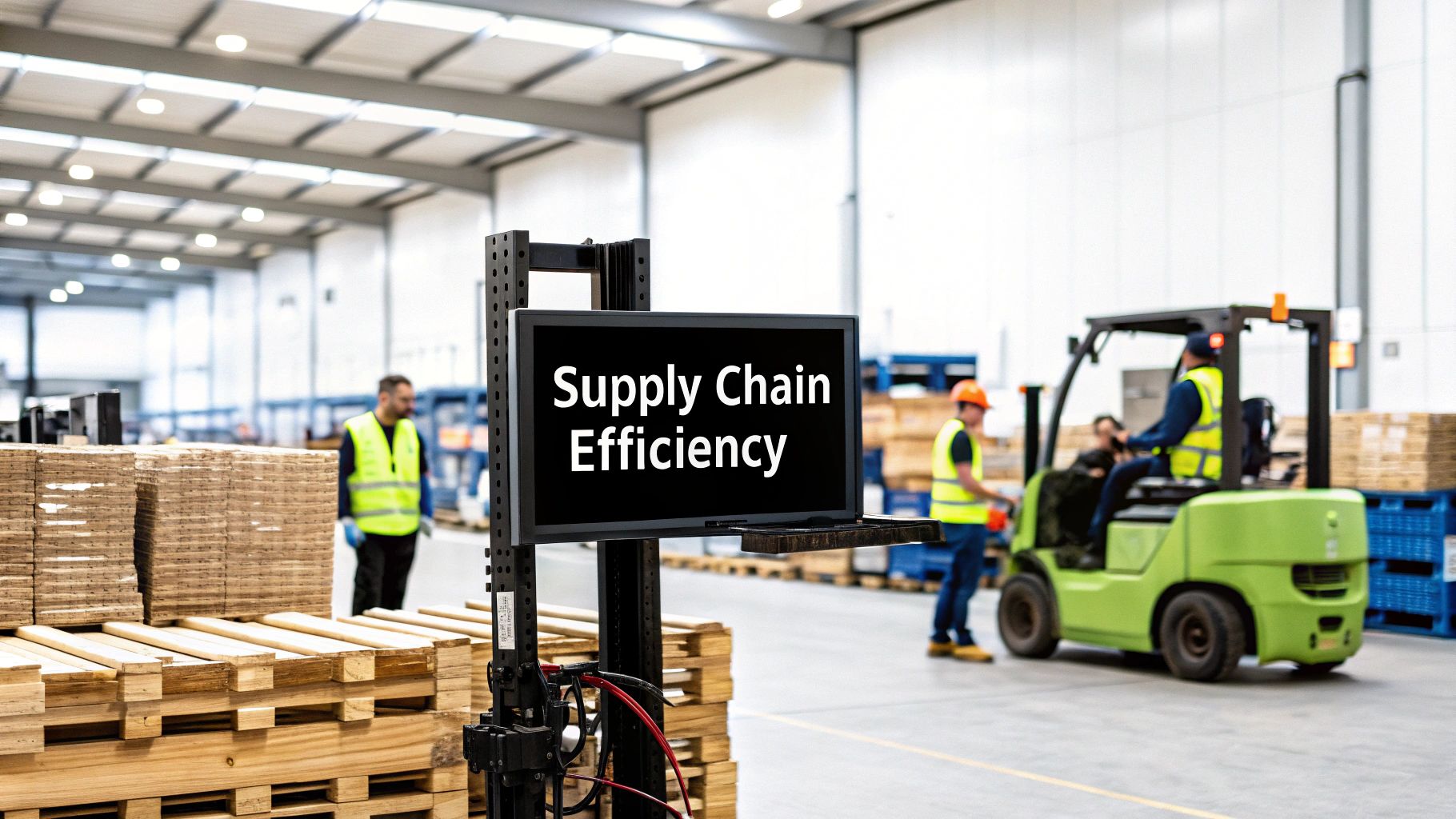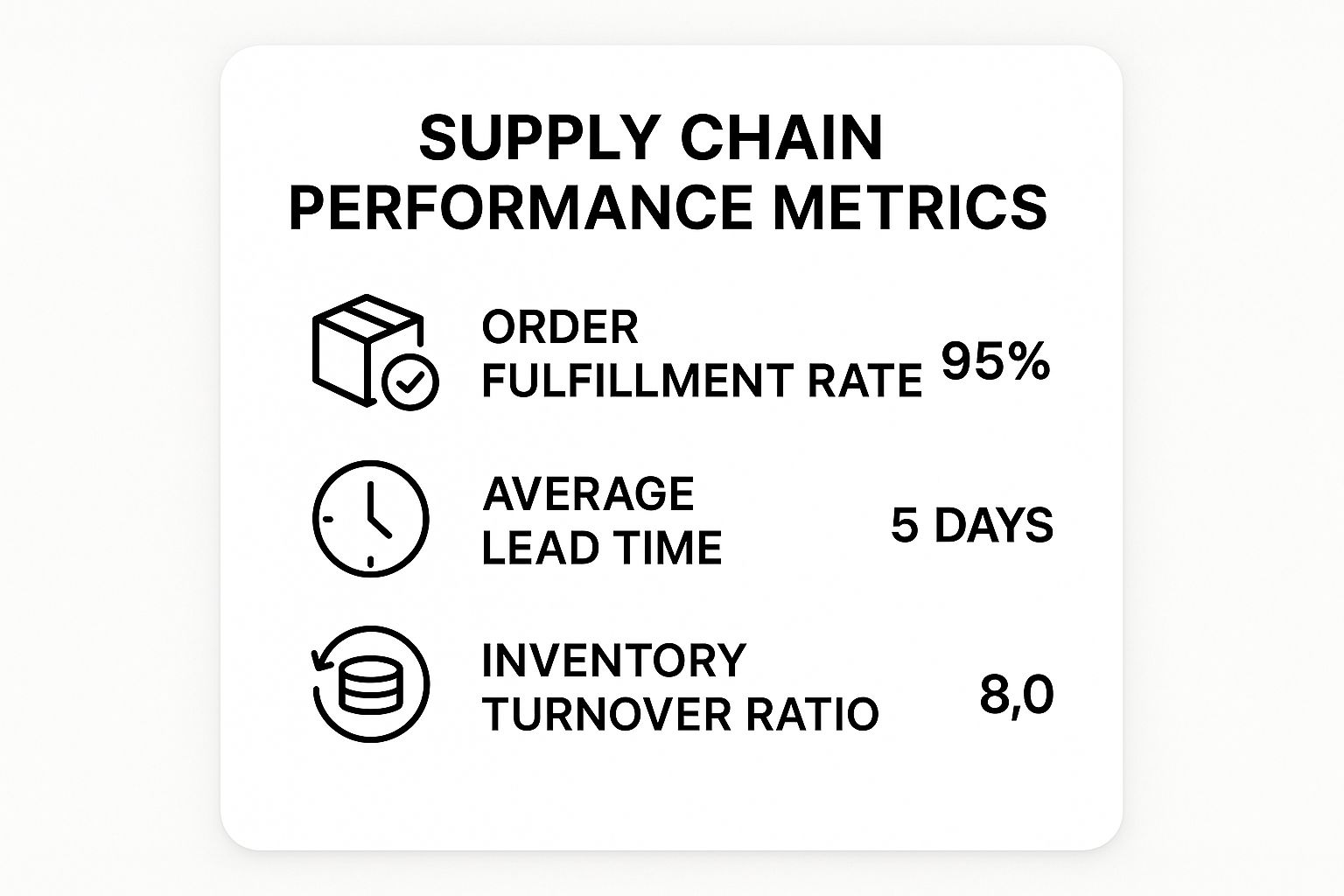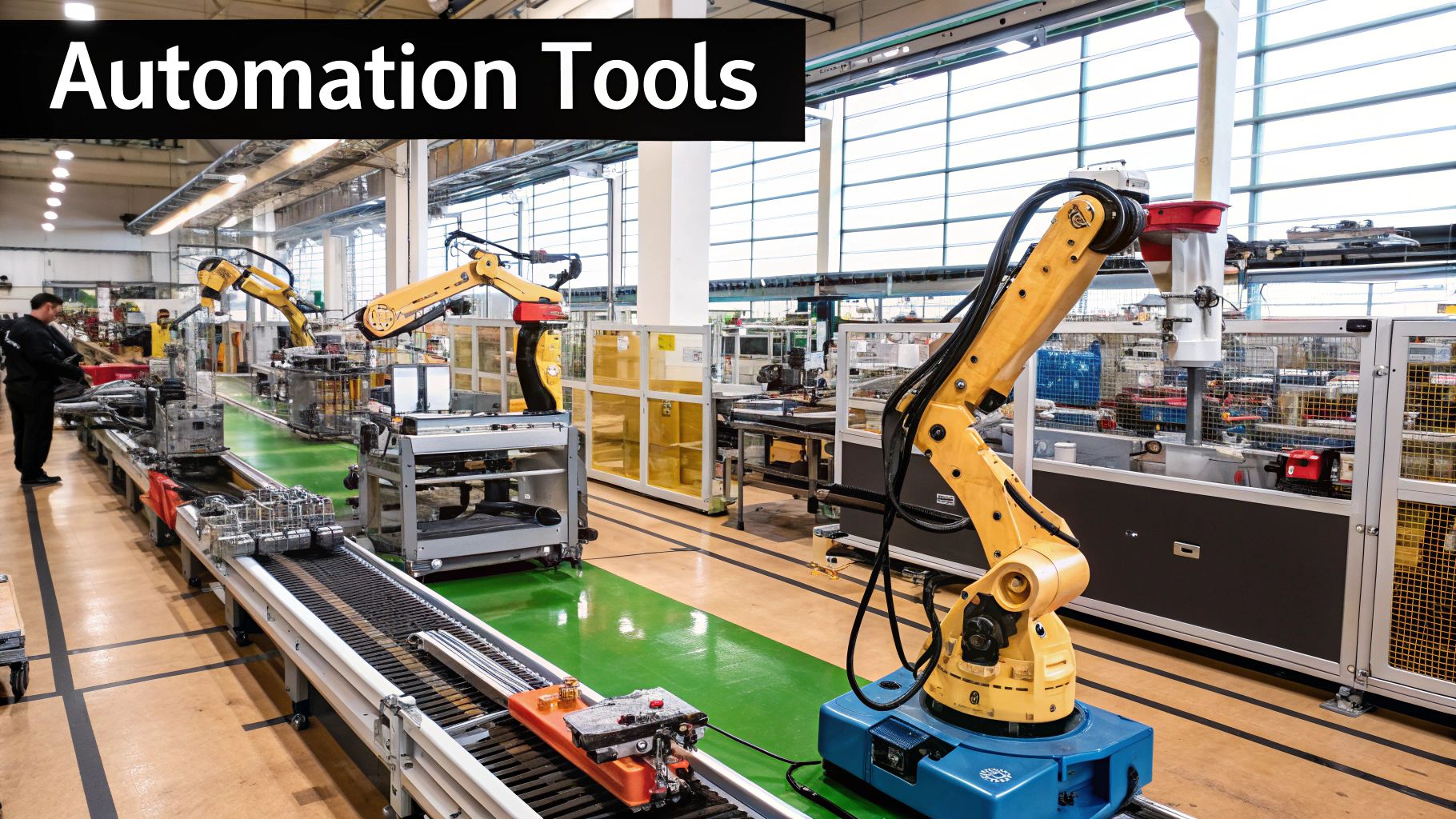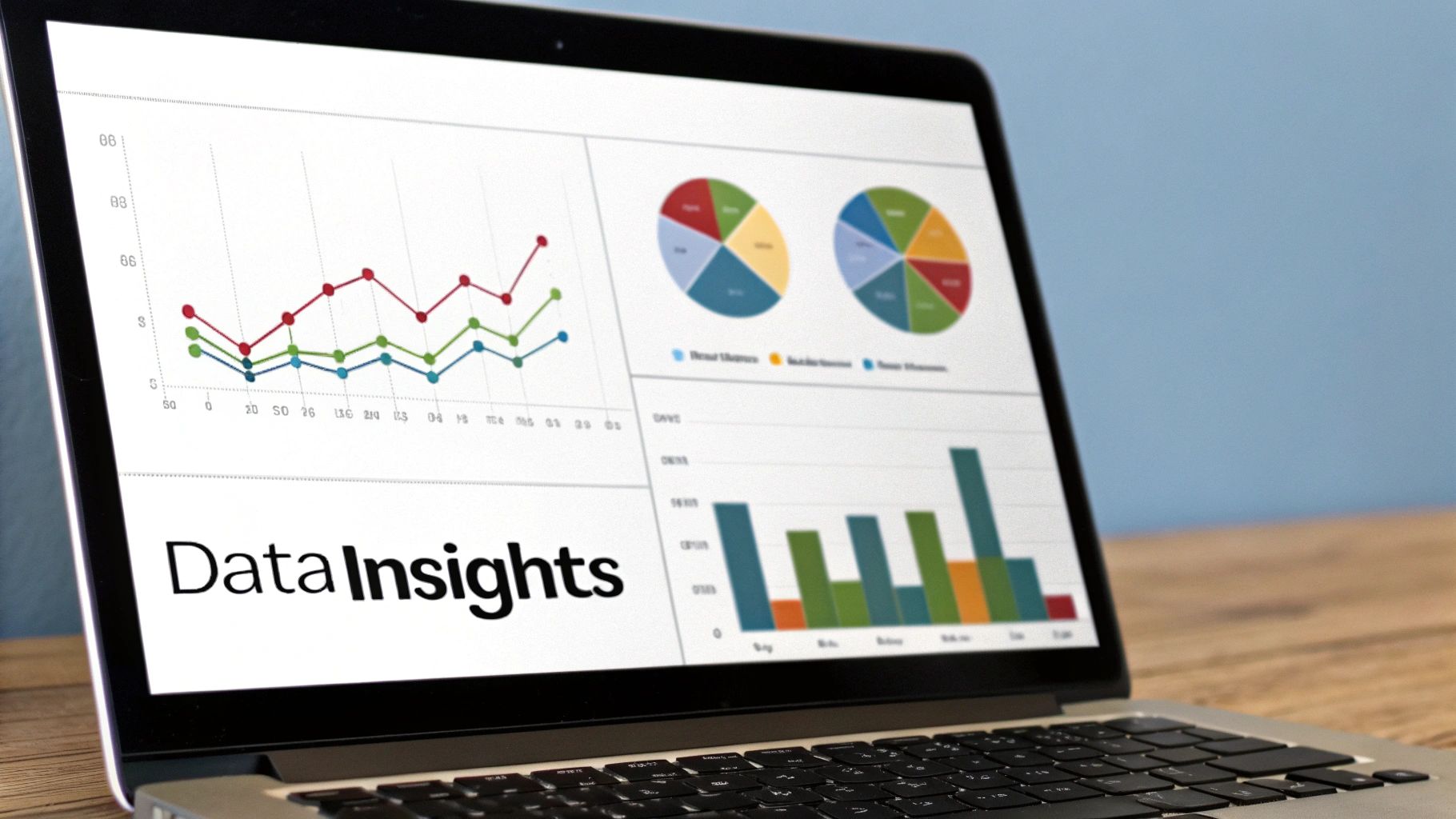Learn how to improve supply chain efficiency with proven strategies. Boost your operations today with our comprehensive guide on supply chain improvement!

Feeling the constant squeeze from delays, skyrocketing freight costs, and never-ending disruptions? If that sounds familiar, you're in good company. Getting a handle on your supply chain efficiency really boils down to three things: getting crystal-clear visibility, adopting the right tech, and building rock-solid partnerships. This isn't about lofty theories; it's about making real-world changes that make your operations more agile and a lot less expensive.
In this market, a clunky supply chain isn't just a headache—it’s a direct hit to your profitability. Every late shipment, every out-of-stock item, and every missed communication sends ripples through your business, affecting costs, customer happiness, and your ability to stay ahead. The real goal here is to flip the script and turn your supply chain from a reactive cost drain into a proactive, resilient advantage.
But where on earth do you start? The web of global logistics can feel impossibly complex. The secret is to begin with a solid understanding of where you stand right now. Without good data, any "improvement" is just a shot in the dark.
Before you start overhauling processes, you need a baseline. That means tracking the Key Performance Indicators (KPIs) that actually paint a true picture of your operational health. These numbers help you zero in on specific weak spots and, just as importantly, see if the changes you're making are actually working.
This infographic breaks down three of the most crucial metrics you should have on your dashboard.

Keeping a close eye on your Order Fulfillment Rate, Average Lead Time, and Inventory Turnover Ratio gives you the hard data you need to make smart, targeted improvements instead of just guessing.
Fixing your supply chain isn't a one-and-done deal. It's about building a strong foundation on strategies that support each other. When these pillars work together, you create a system that's both lean and tough enough to handle whatever comes its way.
Here’s what I mean:
Enhanced Visibility: It’s simple: you can't manage what you can't see. Real-time tracking and open communication with every single partner, from your raw material suppliers to the last-mile delivery driver, are non-negotiable today.
Smart Technology Adoption: Modern tools give you the data and automation to move faster and make better calls. Think of everything from a slick warehouse management system (WMS) to predictive analytics that help you forecast demand with spooky accuracy.
Strategic Partnerships: Don't underestimate the power of your relationships. When you truly collaborate with your suppliers and logistics providers, you get better reliability, more flexibility when things go wrong, and a shared desire for everyone to succeed.
When you focus on these three areas, you create a powerful flywheel. Better visibility helps you use technology more effectively. That tech, in turn, makes it easier to build stronger, more transparent partnerships. It's a cycle of continuous improvement. Plus, many of these efforts tie directly into uncovering new supply chain cost reduction strategies, freeing up cash you can reinvest into the business.
To wrap these concepts up, let's look at how they connect strategy to real-world outcomes.
By building on these pillars, you move from constantly putting out fires to strategically steering your operations toward greater efficiency and resilience.
A truly efficient supply chain does more than just cut costs—it builds a powerful competitive advantage by getting products to your customers faster and more reliably than anyone else. That reliability is what builds trust and keeps them coming back.
Ready to see how smarter logistics can directly impact your bottom line? A great place to start is by taking a closer look at how you manage your full truckload (FTL) and less-than-truckload (LTL) freight.
Get free quote

Let's get practical about technology. It’s not about chasing the newest shiny object, but about strategically picking tools that actually solve your biggest headaches. In logistics, Artificial Intelligence (AI) and advanced analytics are completely changing how we operate by turning mountains of data into clear, actionable advice.
Forget the buzzwords for a minute. The real magic here is shifting your entire operation from reactive to proactive. Instead of scrambling when a shipment gets delayed, you can see potential problems coming and adjust your plans before they happen. That’s a fundamental upgrade to your supply chain's efficiency.
For years, we’ve relied on historical averages and, let's be honest, educated guesses to plan for the future. The problem is, that old approach just doesn't hold up anymore with how fast markets change. AI-powered tools give us a much sharper lens.
By crunching huge datasets—everything from past sales and market trends to weather forecasts and even social media chatter—these algorithms can predict demand with stunning accuracy. This means you can finally stop walking the tightrope between costly overstock and frustrating stockouts that send customers running to your competition.
Think about your own freight for a moment. Accurate forecasting has a direct line to how much you're spending on shipping. The results we're seeing from early adopters are pretty incredible. Integrating AI has been shown to cut logistics costs by around 15%, slash inventory levels by 35%, and boost service efficiency by as much as 65%. These aren't just minor tweaks; they're a huge competitive advantage, all driven by data. You can dig into more of these eye-opening numbers with these supply chain statistics and their impact.
AI isn't here to replace the experts on your team; it's here to supercharge them. These tools do the heavy lifting with data, freeing up your people to focus on strategy, creative problem-solving, and building relationships.
Another area where tech is a complete game-changer is real-time route optimization. A traditional route plan is static—once the truck is out the door, the plan is locked in. But what happens when there's an unexpected road closure, a massive traffic jam, or a sudden storm?
Modern logistics platforms use live data to adjust routes on the fly, which immediately helps your bottom line.
Picture this: one of your LTL shipments is headed downtown when a major accident snarls traffic. An AI-powered system could instantly reroute the driver around the mess, saving hours of delay and making sure the delivery still arrives on time. This is the kind of agility that sets truly efficient supply chains apart.
The market is flooded with supply chain software, and it’s easy to feel overwhelmed. The secret is to focus on your biggest pain points first. Don't go all-in on a complex predictive analytics suite if your most urgent problem is just keeping track of inventory across three different warehouses.
Start with the foundational systems that give you an immediate win:
By putting the right technology in place, you gain the visibility and control you need to build a leaner, more competitive operation. It’s all about making smarter, data-backed decisions at every step, from the warehouse floor to the customer's doorstep.
Ready to see how technology can optimize your FTL or LTL freight costs?
Get free quote

Let's be honest: you can't fix what you can't see. This simple truth is probably the single biggest roadblock for any business trying to tighten up its supply chain. If you’re juggling data from a dozen different places—a spreadsheet from your supplier, a quick email from your carrier, your own internal system—you're basically flying blind.
This complete lack of a unified view, what we in the industry call a single source of truth, is a surefire recipe for expensive delays and constant firefighting. It's time to break down those information walls and turn your supply chain from a black box into your most transparent, predictable asset.
The very first step is just admitting that fragmented information is the enemy. Constantly waiting for partners to manually update you on shipment status or inventory levels is not just slow, it's a magnet for human error. The real goal is to build a connected ecosystem where data flows freely and automatically between you, your suppliers, and your logistics providers.
This doesn't mean you need a massive, multi-million dollar tech overhaul. I've seen companies make huge strides with simple, practical steps. For example, implementing basic track-and-trace tech like GPS on shipments or RFID tags on key pallets gives you a live feed of where your goods are at any given moment.
This real-time information is a game-changer. You stop asking, "Where is my shipment?" because you already know. You can see exactly where it is and when it will arrive, which lets you proactively manage exceptions instead of just reacting to them after the damage is done.
Beyond just tracking a dot on a map, true visibility comes from genuine collaboration. Modern supply chain platforms are designed to be a central hub where everyone involved—you, your supplier, your carrier—sees the same information at the same time. Think of it as a shared command center for your entire network.
When a supplier updates a production timeline, you and your carrier see it instantly. When a truck gets held up by a snowstorm, everyone gets an alert and can immediately start working on a plan B. This kind of shared awareness is what separates an agile operation from one that's always a step behind.
These platforms aren't just for looking at data; they're for taking action. They typically include features that directly boost efficiency:
This approach transforms your relationships from purely transactional to truly strategic. For a deeper look at this, our guide on the importance of supply chain visibility breaks down how transparency builds stronger, more resilient partnerships.
Let's get out of the clouds and look at how this actually impacts the bottom line. I've seen this play out time and time again.
A mid-sized electronics retailer I know used real-time tracking to spot a container of high-demand products stuck at a congested port two weeks before its ETA. With that early warning, they rerouted inventory from another warehouse and tweaked their marketing promotions. The result? They completely avoided a costly stockout and kept their customers happy.
In another case, a food and beverage company used a collaborative platform to monitor its temperature-sensitive LTL shipments. They got an automated alert that a refrigeration unit on one of their trucks was failing. They were able to contact the driver immediately to get it fixed, saving a $50,000 shipment from spoiling.
These aren't just lucky breaks; they are the direct results of having clear, actionable data at your fingertips. Visibility lets you fine-tune inventory based on real-time demand, give customers the accurate ETAs they expect, and spot trouble long before it becomes a full-blown crisis. Stop letting blind spots dictate your success. It's time to demand the visibility you need to take control of your freight and your future.
Get free quote
The days of leaning on a single, centralized source for your critical parts are long gone. A supply chain that hinges on one key partner isn't streamlined—it's a massive liability just waiting to snap. To get ahead today, you have to build a network that’s flexible, diversified, and ready for just about anything.
This really means rethinking your network from the ground up to handle the challenges we all face now. It’s about making a strategic pivot away from the old "all eggs in one basket" model and creating a distributed, multi-faceted web of suppliers. This isn't just a defensive move to dodge risk; it’s a powerful way to drive efficiency itself.
Moving to a diversified sourcing model is probably one of the most impactful changes you can make. When you have several qualified suppliers, ideally in different parts of the world, you create built-in redundancy. If a natural disaster hits one region or a major port shuts down, you aren't left scrambling. You can just seamlessly shift your orders over to another partner.
This approach is a direct antidote to bottlenecks and frustrating delays. Even better, it introduces some healthy competition among your suppliers, which often leads to better pricing, higher quality, and more innovative ideas over the long haul. You end up with more flexibility and more leverage.
A huge piece of this puzzle is striking the right balance between your global and local sourcing options.
The smartest companies I’ve worked with don’t just pick one or the other. They build a hybrid model that blends the cost advantages of global sourcing with the speed and agility of local partners. For many, creating a truly tough operation means taking a deep dive into supply chain resilience strategies that go way beyond just having a few extra suppliers on speed dial.
Let’s play this out. Imagine you're a furniture manufacturer. Your main supplier for a specific type of hardwood is in Southeast Asia—great prices, solid quality. But you've been smart and also maintain a smaller, secondary relationship with a supplier in North America.
Suddenly, international shipping lanes get completely clogged, and your lead times from Asia jump from six weeks to twelve. Instead of calling your customers to tell them they have to wait another month and a half, you activate your North American supplier. Sure, the cost per unit might be a little higher, but you get your orders out on time, protect your revenue, and—most importantly—keep your customers happy.
This is what agility looks like in the real world. It’s about having options already baked into your network so that a disruption doesn't spiral into a disaster. You're not just surviving shocks; you're building a supply chain that can pivot and thrive.
This kind of strategic diversification is quickly becoming a core principle for any modern supply chain. We're seeing a major shift toward re-architecting supply chains into digitally empowered, globally distributed networks designed to boost both efficiency and resilience. Top organizations are deliberately increasing their number of unique suppliers just to spread out their geographic risk. You can learn more about how supply chains are adapting to a shifting global landscape.
Look, building this kind of network takes time and effort, but the payoff is immense. It creates a supply chain that doesn't just withstand challenges but actually uses its flexibility as a competitive weapon, letting you respond to market shifts faster than anyone else.
Need to find reliable FTL or LTL carriers to support your diversified network?
Get free quote

You can have the best tech and the most buttoned-up processes, but at the end of the day, they’re only as good as the people running the show. We often get so caught up in systems and software that we forget about the human element—and that's where the real breakthroughs happen. Investing in your team is one of the most powerful levers you can pull to sharpen your supply chain.
Think about it. A skilled, motivated team is the engine driving your entire operation. They’re the ones on the ground using the new software, building relationships with partners, and spotting those tiny inefficiencies that bleed you dry over time. Without their buy-in and expertise, even the slickest tech solutions will just gather dust.
Let's be honest: the industry is facing a major hurdle right now with a growing talent gap. As supply chains get smarter and more digital, the skills needed to manage them are evolving faster than most teams can keep up. This isn't a small problem; it's a bottleneck that can completely stall your progress.
The numbers don't lie. Labor shortages have become a massive headache for supply chain leaders everywhere. Recent surveys found that 62% see it as a major short-term challenge. What’s even more eye-opening is that a whopping 90% of executives admit their organizations don't have the in-house talent to hit their digitization goals. You can dig deeper into these trends with these insights on supply chain statistics.
This tells us one thing loud and clear: you can't just hire your way out of this problem. The real solution lies in developing the people you already have.
The most direct way to close that gap is through smart, targeted upskilling. This isn't about turning everyone into a data scientist overnight. It’s about giving them the confidence and know-how to work with modern digital tools and make sense of the analytics. Your goal is to help them become data-savvy decision-makers.
Here are a few practical ways to get started:
Beyond any formal training program, the most efficient supply chains I’ve ever seen are built on a culture where everyone feels empowered to make things better. This is the heart of continuous improvement—making problem-solving part of everyone's job, not just a task for managers.
An empowered team is your best defense against inefficiency. The person packing boxes or loading a truck often sees small problems long before they show up on a spreadsheet. When you give them a voice, you unlock a powerful source of practical, ground-level innovation.
To build this kind of culture, you need to open up clear channels for feedback. This could be as simple as a weekly huddle to talk about what's working and what's not, or even a digital "suggestion box" where good ideas are actually reviewed and rewarded.
The most important part? You have to act on the feedback. When an employee sees their suggestion get implemented, it sends a powerful message that their expertise matters. This creates a positive cycle, encouraging more people to speak up and actively hunt for ways to improve every single day. Ultimately, every dollar you invest in your people pays you back tenfold, turning your team into your greatest competitive advantage.
https://www.youtube.com/embed/qhHpWf_WPOc
Diving into supply chain optimization can feel like a huge undertaking, and it's natural for questions to pop up along the way. We get it. To help clear the path, we’ve put together some straightforward answers to the questions we hear most often from businesses looking to get leaner and more effective.
If you do just one thing, start with visibility. Seriously. You can't fix what you can't see. Before you can dream of optimizing, you need a crystal-clear, real-time view of your entire supply chain—from the moment an order is placed with your supplier to the final delivery at your customer's door.
Think of it like this: making changes without full visibility is just guesswork. You might get lucky, but you're more likely to cause problems elsewhere.
So, where do you begin? Start by literally mapping out your key processes. Follow the journey of an order and pinpoint exactly where information gets stuck or goes dark. Is it waiting for a carrier to confirm a pickup? Or are you stuck relying on a weekly spreadsheet from your 3PL that's already outdated by Tuesday?
Once you’ve identified those blind spots, you can look for technology that pulls all that scattered data into one place. This single source of truth is the foundation. It will immediately shine a light on your biggest bottlenecks, giving you the hard data you need to decide what to fix first.
Struggling with visibility on your freight costs? Getting a clear quote is the first step.
Get free quote
This is a great question, and the answer is simpler than you might think. For small businesses, it's all about being smart and strategic, not just throwing money at the problem. You can make huge strides without a massive investment.
First off, double down on your relationships. Strong communication with your key suppliers and carriers can solve a surprising number of headaches. Regular check-ins and shared forecasts can prevent the kind of misunderstandings that lead to expensive delays and last-minute panic.
Next, get ruthless with your inventory. You don't need a fancy, expensive system to start. A simple ABC analysis is a powerful tool for classifying your stock. This lets you focus your attention on your high-value "A" items and helps you avoid tying up precious cash in slow-moving "C" products.
I've seen so many small businesses unlock huge savings just by rightsizing their inventory. Every dollar not sitting on a shelf as excess stock is a dollar you can reinvest into actually growing your business.
Finally, explore the world of affordable, cloud-based software. There are fantastic tools out there for specific tasks like inventory management or shipment tracking that won't break the bank. You don't need a massive, all-in-one system to see major improvements in how your operation runs.
Measurement is everything. To know if your changes are working, you have to track the right Key Performance Indicators (KPIs). The trick is to ignore the "vanity metrics" and focus on the numbers that directly impact your operations and, ultimately, your bank account.
Here are a few of the most critical KPIs you should be watching:
Perfect Order Rate: This is the gold standard. It’s the percentage of orders you deliver on time, complete, damage-free, and with perfect paperwork. A high perfect order rate is a sign of a well-oiled machine.
Cash-to-Cash Cycle Time: This sounds complex, but it's simple: how fast do you turn your investment in inventory back into cash? A shorter cycle is always better—it means your money is working for you, not sitting on a shelf.
Inventory Turnover: This tells you how many times your entire inventory is sold and replaced over a period. A high turnover rate generally points to healthy sales and lean inventory practices.
When you zoom in on the logistics piece of the puzzle, two other metrics are absolutely essential.
The best approach? Benchmark where you are right now on a few of these KPIs. As you make changes, track them religiously. This will give you undeniable proof of what’s working and where you still have room to improve.
Knowing your freight costs is a vital part of this measurement. Find out what you should be paying.
Get free quote
At FreightQuotesNow, we provide the tools and expertise to help you gain control over your shipping costs and improve your overall supply chain performance. Our network of over 50,000 vetted carriers ensures you always get competitive rates for your FTL and LTL shipments, helping you build a more efficient and resilient operation. Get your free quote today and see how much you can save at https://www.freightquotesnow.com.